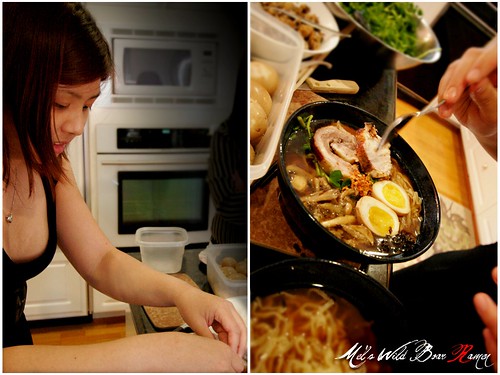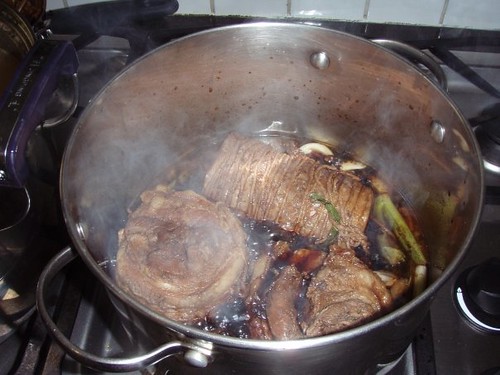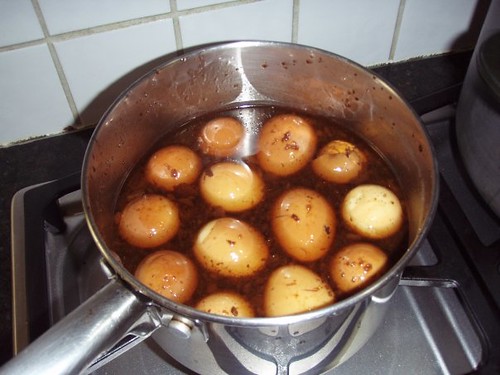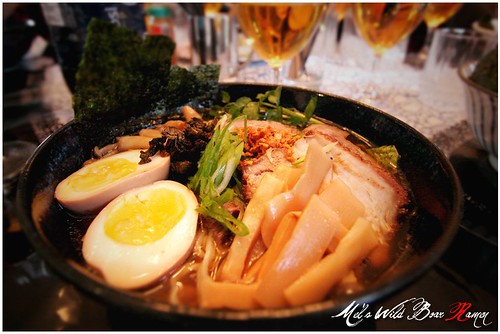
Okay, so my sweet tooth took a hit this Halloween weekend, so just to change it up a bit while I recuperate from the sugar high, I'm going to detail one of my other passions: Japanese Ramen. I loooooove this dish and it's the best comfort food in the world! And living in Vancouver where there has recently been a ramen influx in the last 8 years, I can safely say that I feel blessed living in the next best city to have Japanese food outside of Japan! I heart the quirkness of Tampopo and much like the female protagonist, I strive each time to creating the perfect bowl of ramen. Every year, I host at least 2 ramen nights which is essentially a giant cook day where I entertain the dream of me becoming a master ramen chef. All who participate do so quite willingly and hungrily!
For the uninitiated, Japanese ramen is more than just a humble dried pack of noodles that sustains the college crowd. It is a relatively new addition to Japanese cuisine and is actually an adaptation of Chinese noodle soups that was brought over when by Chinese migrants to Japan. According to Wikipedia, the 1900s saw many shall noodle shops opening selling gyozas and noodle soups known as shina soba. After the Second World War, the Japanese government began pushing more of the local population into adopting wheat flour imported from America as part of their regular diet. Hence the ripe conditions for a ramen boom.
There are many varieties to Japanese ramen than meets the eye! Many regions in Japan boast variations and local creations that are world famous. Simple tweeks to the ingredients can change the flavours and experience one has with ramen, much like terroir affects the flavours of wine. Instead of continuing this long rant (which I can get really carried away with!) I'll refer you to this wonderful site, Rameniac so you can discover the many different regional varieties of ramen.
Anyhoo! Onward we go! So what inspired me to create my "Forest God Ramen"? Two things: Princess Mononoke, and this wonderful review of of a Kyoto wild boar ramen. I WANT to eat a forest god! And seeing as there is no way for me to navigate my way to the remote mountains off of Kyoto, I had to recreate the flavours of this dish. Boar side is not cheap (Here in Canada I believe it ran me up to $60 for 2 sides) so pork side may be a much cheaper alternative. The boar bacon side also has less fat, but that does not mean it isn't just as flavourful! Well, without much further ado, here it is in all it's glory! (My apologies if the measurements are not exact, but it's all about feel and improvisation!)
Forest God Ramen (Wild Boar Ramen)
Soup Stock:
3 lbs Pork bones
2 Pork hooves, split and cleaned
2 lbs Chicken bones
1 head of Garlic, chop top off
1 large Onion, quartered
1 large Asian Carrot, Chopped in thirds
3 stalks Celery, roughly chopped
1 Handful dried Anchovies (found at most Asian Markets, they kind of look like dried smelt)
4 dried Shitake mushrooms
1 piece dried seaweed/kelp (3 inches wide and long)
2 dried Bay leaves
Handful of black peppercorns
Slab of Wild Boar/pork side (See below)
String/twine
1. Remove any cartilage/bone from your boar/pork side, KEEP THE PIECE INTACT! Once you do this, you want to roll the side into a spiral, kind of like a meaty cinnamon bun. Wrap it tightly and with the twine, wrap it around and tie it like you would with a roast or porchetta.
2. Place all the ingredients above into a BIG stock pot and add water. The bigger the better! You will now want to bring it to a low boil for 4 hours minimum (good Tonkotsu stock takes anywhere between 4-8 hours simmering time). At the 3 hour point, you will want to remove the boar/pork sides and set aside. Keep boiling the stock until 5-6 hour point. Strain liquid and season with salt (not too much as you will be using the tare from the chashu below)
Here are some pictures for reference:
Chashu (Boar/Pork side spirals):
1 slab Wild boar side (Bacon cut of meat)
1 slab Pork side
3 cups Soy sauce
1 cup Japanese Rice wine
2 knobs ginger, sliced
Half a head of Garlic, peeled and smashed
1 stalk of Japanese leeks (or 3 stalks of green onions) chopped coarsely.
2-3 Tbsp Sesame oil
2 Cups Tonkotsu Soup Stock
1. Pour all the ingredients into another pot and turn the stove onto medium heat. When it comes to a boil, place the boiled meat slabs into the tare and bring to a simmer. Boil and marinate for 30-45 minutes, rotating the meat every so often. Your chashu should look like this:

2. After it is done marinating, take out the sides and place in a fridge for at least 4 hours to cool. This will make it easier to slice into when serving and you will get some nice spirals. Strain the liquid and keep the left over tare as you will need it for the soft-boiled eggs as well as flavouring the soup. It should look like this after boiling the meat.

Alternative Method:
If you really don't want to bother with the twining and rolled effect, or just want a different BBQ effect, you could always just boil the side as is. When it is done at the 3-4 hour make, take it out and baste with honey/soy sauce mixture. In a preheated 350F oven, broil the pork until it become crispy and caremelized, around 15-20 minutes. Cool in a fridge as above until serving and slice thinly.

Soft-Boiled Marinated Eggs
12 Eggs
Bowl of ice and water
Tare from Chashu
1. Boil the eggs for 5 minutes. Afterwards, transfer them to the ice bath.
2. Once it is cooled, peal eggs (carefully! They are very delicate!)
3. Let them marinate in the tare for 2-4 hours (depending on how salty you want them)
4. SAVE TARE! When serving, slice eggs in half to reveal their gooey insides!

To Serve:
When making ramen you want all your condiments ready to go as when you boil the noodles you want to keep the chewy, al dente effect of the noodles in the bowl. Make sure the stock is at a simmer. I would highly reccommend using frozen Japanese ramen noodles, but if you must, dried ramen works alright too. There's a really REALLY interesting recipe developed by Marc Matsumoto at Norecipe.com that tells you how to make ramen noodles from scratch. I've yet to try it, but this guy sounds just as obsessed as I do at finding the perfect bowl of ramen! I like to use this frozen Nissin brand I get from Fujiya/Osaka T&T:

Here is a list of great condiments to go with the Forest God Ramen:
-Nori (seaweed sheets)
-Menma (Pickled bamboo shoots)
-Diced green onions
-Sauteed wild mushrooms (I like using chanterelles, pochini, shitake, and shimeji if I can find them, but button mushrooms work well too. Be creative!)
-"Burnt" Green onions (Pan fry some diced onions with oil until caremelized)
-Fried diced garlic (Deep fry some diced garlic)
-Shichimi (A chili spice added to soups. It comes in a small orange bottle and you can get them at most Asian/well stocked markets)
Finally! Here's how you assemble the ramen!
1. Cook ramen noodles according to package in boiling water.
2. While noodles are boiling, pour 2 tbsp of tare into the bottom of a deep noodle bowl. Add 2-3 ladles of boiling Tonkotsu stock.
3. When noodles are cooked, strain them and place them in the soup. Arrange condiments in a circle. Presentation is key and will make it more delectable!
The end product should look somewhat like this:


No comments:
Post a Comment